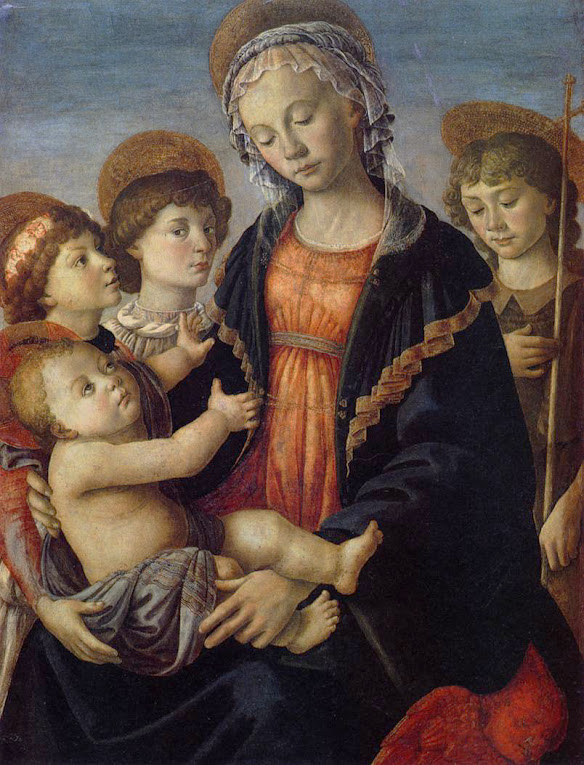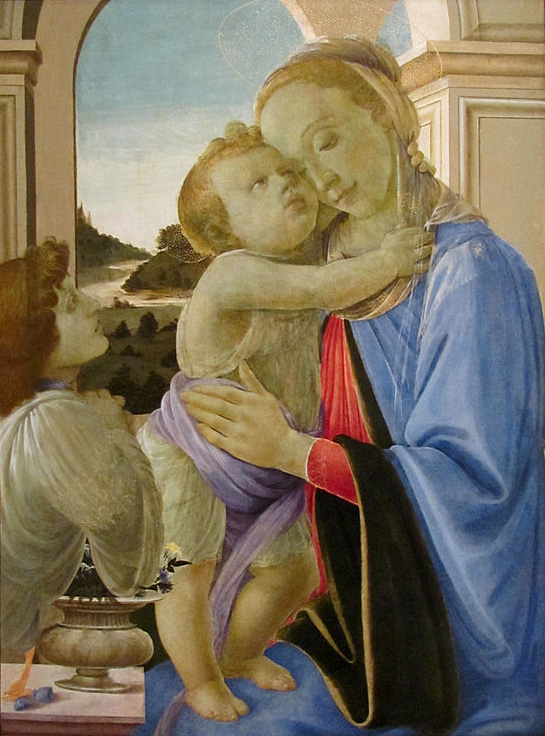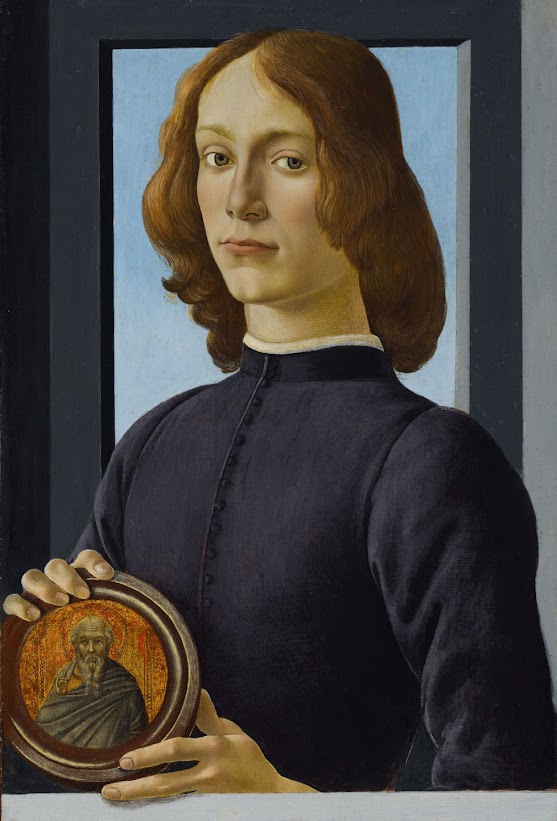 |
| Thought to be a self-portrait: detail from The Adoration of the Magi © The Art Archive/Galleria degli Uffizi, Florence / Alfredo Dagli Orti |
At the height of his fame, the Florentine painter and draughtsman Sandro Botticelli was one of the most esteemed artists in Italy. His graceful pictures of the Madonna and Child, his altarpieces and his life-size mythological paintings were immensely popular in his lifetime.
It is thought that Botticelli first trained with Maso Finiguerra, a goldsmith, before entering the studio of the artist Fra Filippo Lippi. He began his career painting frescoes for Florentine churches and cathedrals, and worked with the painter and engraver Antonio del . By 1470, he had his own workshop.
In 1472, Botticelli joined the Compagnia di San Luca, the confraternity of Florentine painters. He also employed Filippino Lippi, his late teacher's son, as his apprentice, and broke convention by completing Filippino's version of 'The Adoration of the Kings' - it was far more usual for an apprentice to finish a painting by his master rather than the other way round.
Botticelli's apprenticeship with Fra Filippo gave him excellent contacts. His master had enjoyed the patronage of some of the leading families in Florence, such as the Medici. Botticelli in turn spent almost all his life working for the Medici family and their circle of friends, for whom he painted some of his most ambitious secular paintings such as 'Primavera' (in the Uffizi, Florence).
Botticelli's star was in the ascendant. Such was his reputation that, in 1481, he was summoned by the Pope to Rome to help decorate the walls of the recently completed Sistine Chapel in the Vatican. He painted frescoes depicting scenes from the Life of Moses and the Temptations of Christ and was also responsible for a number of papal portraits. The nature of this task demonstrates how highly regarded he was around this time, and it was the only occasion he is known to have worked outside Florence. A year later, Botticelli returned to Florence, to continue with the most prolific stage of his career.
The period from 1478-90 saw Botticelli at his most creative. This was the period during which he produced his famous mythological works, such as 'The Birth of Venus' (in the Uffizi, Florence) and 'Venus and Mars.' In these he successfully combined a decorative use of line with elements of the classical tradition, seen in the harmony of his composition and the supple contours of his figures.
During the last 15 years of his life, Botticelli's work appeared to undergo a crisis of style and expression.
The 1490s was a turbulent decade - the Medici had been expelled from Florence and Italy's peace disrupted by invasion and plagues. Botticelli rejected the ornamental charm of his earlier works in favour of a more simplistic approach that seemed crude and heavy-handed by contrast. These later paintings, with their deep moral and religious overtones, also suffered a comparison with the sophisticated aesthetic of artists such as Michelangelo and Raphael.
According to Vasari in his book 'The Lives of the Artists', in his latter years Botticelli became a follower of the fanatical Dominican friar Savonarola, and the pious sentiment of his later works would seem to suggest some involvement in the religious and political upheavals in Florence at the time. 'Mystic Nativity' is Botticelli's most ambitious painting from this period and reflects this sense of apocalyptic foreboding.
Vasari also suggests that, as his work fell out of favour, Botticelli became melancholic and depressed. He had never married, preferring the company of family and friends. Having always been known for his high spirits and quick wit, the image of Botticelli's final years as a rapid decline into poverty, isolation and mental anguish is a poignant one.
After his death, his name all but disappeared until the late 19th century, when a developing appreciation for Florentine arts and culture brought about a renewed interest in his work.
Biography from The National Gallery, London
This is part 1 of a 6-part series on the works of Sandro Botticelli:
 |
| 1465-67 Madonna and Child with an Angel tempera on panel 87 x x 60 cm Spedale degli Innocenti, Florence |
 |
| 1465-70 Madonna and Child with Angels (attributed to Sandro Botticelli) oil and tempera on poplar panel 86.7 x 57.8 cm National Gallery of Art, Washington, DC |
 |
| 1465-70 The Virgin and Child with two Angels and the young St John the Baptist tempera on panel 85 x 62 cm Galleria dell'Accademia, Florence |
 |
| 1467-68 Madonna and Child with an Angel tempera on panel 152 x 77 cm Musée Fesch, Ajaccio |
%20temp%5Bera%20on%20panel%2072%20by%2050c%20m%20Uffizi%20Gallery,%20Florence.jpg) |
| c1467 Madonna and Child (Madonna della Loggia) temp[era on panel 72 by 50 cm Uffizi Gallery, Florence |
 |
| c1468-69 Madonna and Child with two Angels tempera on panel 100 x 71 cm Museo Nazionale di Capodimonte, Naples |
 |
| c1468 Madonna and Child with adoring Angel tempera on panel 88.9 x 68 cm Norton Simon Museum, Pasadena, CA |
 |
| c1468 Madonna and Child with the infant St. John tempera and oil on poplar panel 90.7 x 67 cm Louvre, Paris |
 |
| 1469-70 Madonna in Glory with Seraphim tempera on panel 120 x 65 cm Uffizi Gallery, Florence |
 |
| 1469-70 Madonna of the Rose Garden tempera on panel 124 x 65 cm Uffizi Gallery, Florence |
 |
| 1469c Portrait of a Young Man tempera on panel 51 x 33.7 cm Pitti Palace, Florence |
 |
| 1470-71 Adoration of the Magi tempera on panel 131.5 diameter The National Gallery, London |
 |
| 1470-71 Adoration of the Magi detail tempera on panel 131.5 diameter The National Gallery, London |
 |
| 1470-72 Sacred Conversation: Altarpiece of Sant'Ambrogio tempera on panel 170 x 195 cm Uffizi Gallery, Florence |
 |
| 1470-74 Virgin and Child with an Angel tempera on panel 85.2 x 65 cm Isabella Stewart Gardner Museum, Boston, MA |
 |
| 1470-75 The Adoration of the Kings tempera on poplar wood panel 130.8 diameter The National Gallery, London |
 |
| 1470-75 Three Scenes from the Story of Esther tempera? on wood panel 48 x 132 cm Louvre, Paris |
 |
| 1470-75 Three Scenes from the Story of Esther detail |
 |
| 1470-75 Three Scenes from the Story of Esther detail |
 |
| 1470-75 Three Scenes from the Story of Esther detail |
 |
| 1470-75 Virgin and Child with Young St John the Baptist tempera? on wood panel 90 x 67 cm Louvre, Paris |
%20V&A,%20London.jpg) |
| 1470-80 Portrait of a Lady known as Smeralda Bandinelli tempera on panel 87 x 62 cm (with frame) V&A, London |
 |
| c1470-80 Three garbed Figures silverpoint on paper 19.7 x 24.3 cm Städel Museum, Frankfurt |
 |
| c1470 Adoration of the Kings tempera on wood 50.2 x 135.9 cm The National Gallery, London |
 |
| c1470 Adoration of the Kings detail tempera on wood 50.2 x 135.9 cm The National Gallery, London |
 |
| c1470 Adoration of the Kings detail tempera on wood 50.2 x 135.9 cm The National Gallery, London |
 |
| c1470 Adoration of the Kings detail tempera on wood 50.2 x 135.9 cm The National Gallery, London |
 |
| c1470 Adoration of the Kings detail tempera on wood 50.2 x 135.9 cm The National Gallery, London |
 |
| c1470 Fortitude tempera on panel 167 x 87 cm Uffizi Gallery, Florence |
 |
| c1470 Fortitude detail tempera on panel 167 x 87 cm Uffizi Gallery, Florence |
 |
| c1470 Madonna and Child and Two Angels tempera on panel 100 x 71 cm Museo Nazionale di Capodimonte, Naples |
 |
| c1470 Madonna and Child with an Angel tempera on wood panel 84 x 65 cm Isabella Stewart Gardner Museum, Boston |
 |
| c1470 Madonna and Child with an Angel detail tempera on wood panel 84 x 65 cm Isabella Stewart Gardner Museum, Boston |
%20tempera%20on%20panel%20170%20x%20194%20cm%20Uffizi%20Gallery,%20Florence.jpg) |
| c1470 Madonna and Child with Six Saints (Sant'Ambrogio Altarpiece) tempera on panel 170 x 194 cm Uffizi Gallery, Florence |
 |
| c1470 Madonna with Child Jesus, St. John and Angel tempera on panel 108 x 11 cm National Museum, Warsaw, Poland |
%20Muse%CC%81e%20du%20Petit%20Palais,%20Avignon.jpg) |
| c1470 Virgin and Child tempera on wood panel (size not given) Musée du Petit Palais, Avignon |
 |
| 1470s Portrait of a Young Man holding a Roundel tempera on poplar wood panel 58 x 39 cm Private Collection |
 |
| 1470s Portrait of a Young Man holding a Roundel detail tempera on poplar wood panel 58 x 39 cm Private Collection |
 |
| 1472 The Return of Judith to Bethulia oil on panel 31 x 24 cm Uffizi Gallery, Florence |
 |
| c1472 The Discovery of the Murder of Holofernes tempera on wood panel 31 x 25 cm Uffizi Gallery, Florence |
%20Columbia%20Museum%20of%20Art,%20South%20Carolina.jpg) |
| c1473-75 Nativity fresco transferred to canvas (size not given) Columbia Museum of Art, South Carolina |
 |
| 1474 Saint Sebastian oil on poplar wood panel 154 x 75 cm Gemäldegalerie, Berlin |
 |
| c1474-75 Portrait of a Man with the Medal of Cosimo the Elder tempera on panel 57.5 x 44 cm Uffizi Gallery, Florence |
No comments:
Post a Comment
Note: only a member of this blog may post a comment.